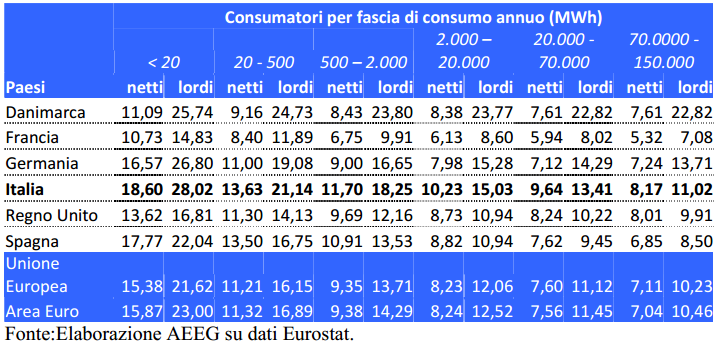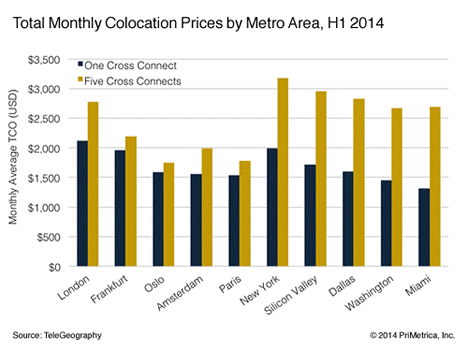Small survey about costs and differences between Italian and European datacenters
When an italian company decides to create an infrastructure to provide services in Italy and in Europe, the first question to arise is the choice of the datacenter and its location. Who provides any service can take lots of advantages in having its servers in different and distant places: first, a fault tolerance system and a disaster recovery solution, and secondly, low latencies and a service as close as possible to its clients.
Which location suits better the needs? Is it true that Italy has more expensive housing costs than the rest of Europe due to the higher costs of energy? What advantages might arise when transferring an infrastructure in Amsterdam or in London? And who would take care of the manutention operations that require a physical presence?
Here you have some data and consideration that can help you to find an answer to those question.
The components that determine the cost of housing services offered by datacenter are plenty, but we can highlight the most important:
- Cost of the building and its position (purchase/rent)
- Cost of electricity
- Cost of air conditioning
- Cost of connectivity and bandwidth
- Cost of personnel
- Additional services integrated in the same offers.
- A component relative to the market which refers to (for example, some places have an higher market value than some others)
Reading this list is enough to understand that the overall cost of an housing service is surely not directly bounded to the cost of the electricity. Perhaps electricity might cost less in a certain country or even continent, but in the end the sum of all the costs always balance the equation by levelling the costs that are paid in different countries.

For instance in the article we cite below, we take into account 2 different configurations for a colocation service for 1 rack-mount system. To sum up, the difference of price between America and Europe for a specific configuration, the simplest, is small: $1800 in Europe against 1700$ in America, which means that it costs 5% less overseas; but if the configuration changes on an interconnection standpoint, Europe gets widely cheaper:
In order to get a clearer image of the situation we have interviewed Luca Beltramino, managing director of the italian division of Telecity Group, one of the most important companies that manage datacenter in Europe: they own datacenters in London (7), Milan (3), Paris (3), Dublin (4), Amsterdam (5) and Stockholm (3). From the inside of the company, cost differences between Italy and Europe can be clearly evaluated. According to Telecity Group, in Italy electricity is the second most expensive factor, being the cost of the personnel, and account for almost 35% of the total expenses. In Sweden, for example, this cost lowers, also thanks to a better climate that requires less air conditioning, by 15/20 points the EBITDA (Earning Before Interest, Taxes, Depreciation and Amortization).
As Beltramino explained us, in Italy it’s not the cost of the kWatt that really makes a difference: a company like Telecity Group, by means of agreements on a national level on the free market of electricity, can fetch a competitive price. The trouble, which is also relative to the cost of personnel, is the taation, which is sensibly higher than in the rest of Europe. The 2012 law on energivorous -which offers tax breaks for those companies that consume a lot of energy- doesn’t involves datacenter, which still remain significantly burdened in comparison with Europe.
“Nonetheless we remain neutral with respect to the telecommunication operators; connectivity is not a particularly high cost with respect to energy and personnel”, told us Beltramino. In this case too the advantage for a group like Telecity is the wholesale purchase of the entire group, which has 400 european carriers, 25 in Milan alone.
Luca Beltramino adds that a component that must not be underlooked is the market itself: the are cities where costs are historically high. A premium rack in London costs more than in Milan, while prices in France and Germany are essentially the same. Other cities like Amsterdam have many clients, even not from Europe, not because prices are way lower than in Milan, but because the whole bureaucratic and economic system of the Netherlands is built to simplify the companies that want to have a business there, even on a language level, tax wedge and custom operations of the goods.
Andrea Moine - Offering Manager at IT net - instead told us that the electricity cost is surely higher than the rest of Europe, although it’s not the only thing that determines the colocation prices.
We have gathered information, by participateing to the last three editions of the World Hosting Day Global (which is held in Germany at Europa-Park Rust), on costs and those data too have confirmed, for instance, that buying a rack in Italy or in Germany has no relevant difference in terms of costs.
For those who would like to evaluate the colocation of their own server in Europe, we’d like to recommend this site that has an useful map of all the european datacenter:
http://www.datacentermap.com/western-europe/
The concentration in Europe and in the main cities can be studied thanks to the following graphs:
As it clearly shown, the higher concentration is in the most important cities of each country; in the capitals and in the most important cities usually a better structured connectivity is an advantage and it’s also available at a more favorable price, on the other hand the physical spaces, that is, land and buildings, on which datacenter are built, have an higher price per square metre and some limitations in terms of space are present. Therefore datacenter have less chances to expand, which means that some economies of scale won’t be exploited.
Another element to ponder upon for those who think about “going” in Europe with its server is the remote management of the machines. It is clear that, even at the time of low-cost flights, it’s inconceivable a periodic technical intervention performed by a technician that goes and returns in a day in Amsterdam or London. To overcome this situation, for instance, Telecity Group offers two possible alternatives: the use of server bought and directly managed by them, with an hardware costs that is spread on the whole duration of the contract, or the intervention of Telecity technician on the clients’ machines. Beltramino explained us that statistically the italian companies that rely on them with the latter approach is just 5% of the total cases.
At the end, it’s important to think about the whole italian and european datacenter subject without preconceptions: it’s important to evaluate the impact of the transfer or the colocation according to the italian law and the clients’ requests. Even if a second datacenter for offering a purely redundant service is being considered, it’s good practice to carefully evaluate all the costs and all the possible solutions before relying on stereotypes, like “in Europe it costs less”. The final results will depend not just on the datacenter, but also on the services and the support that will be given to the clients.



























